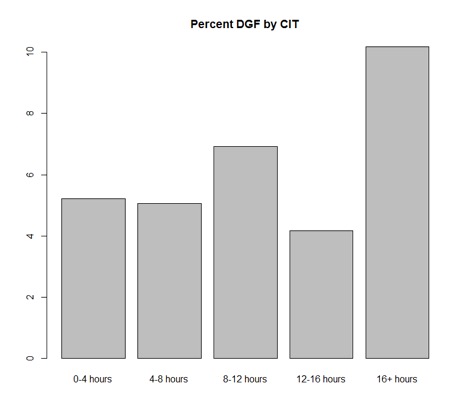Impact of Cold Ischemia Time on Outcomes in Kidney Paired Donation (KPD).
1UWHealth, Madison
2UMN, Minneapolis
Meeting: 2017 American Transplant Congress
Abstract number: 255
Keywords: Kidney transplantation
Session Information
Session Name: Concurrent Session: Living Kidney Donation: Post Donation Issues
Session Type: Concurrent Session
Date: Monday, May 1, 2017
Session Time: 2:30pm-4:00pm
 Presentation Time: 2:42pm-2:54pm
Presentation Time: 2:42pm-2:54pm
Location: E450b
Cold ischemic time (CIT) is an established risk factor for delayed graft function (DGF) in DD kidney tx. Impact of prolonged CIT, in the context of KPD across large distances, is unknown.
Adult, non-preemptive, recipients of KPD tx were identified in the SRTR registry between 1/1/2002 and 6/30/2015. The association of CIT with DGF, graft and patient survival in these KPD recipients were examined. DGF was defined as dialysis within the first week after tx. 2705 KPD tx met inclusion criteria.
Donor and recipient characteristics by DGF are shown in Table 1. CIT was available for 2359 (87.2%) KPD tx. The median CIT was 2.25 hrs (25th–75th percentile: 1.0–7.41 hrs). The median CIT was 2.25 hrs (25th–5th percentile: 1.0–7.41 hrs). 61.9% of KPD transplants had CIT of 0-4 hrs, 15.1% had 4-8 hrs CIT, 13.5% had 8-12 hrs CIT, 7.1% had 12-16 hrs CIT and only 2.5% of KPD tx had >16 hrs CIT. 66.1% of KPD occurred within the same institution (median CIT 1.4 hrs); 33.9% were between institutions (median CIT of 8.55 hrs). The % of KPD between centers has increased over time, up to 45.0% of all KPD transplants in 2014-2015. In an analysis adjusting for the factors in Table 1, CIT was not associated with DGF (OR per 4 hr increase in CIT = 1.05, p = 0.42), graft survival (HR per 4 hr increase = 0.96, p = 0.39), death censored graft survival (HR per 4 hr increase = 0.93, p = 0.29) and overall patient survival (HR per 4 hr increase = 0.95, p = 0.50). Importantly, limiting this analysis to KPDs between institutions did not significantly change the findings. However, when examining the actual rates of DGF in relation to CIT (Fig 1), there was a trend to increased DGF in those kidneys with CIT>16hrs.
Conclusions: In adjusted analysis, increasing CIT had no impact on outcomes in KPD. However, although the “n” is small, the raw data (Fig 1) suggests a trend of increased DGF with truly prolonged CIT.

CITATION INFORMATION: Redfield R, Vock D, Hayes R, Matas A. Impact of Cold Ischemia Time on Outcomes in Kidney Paired Donation (KPD). Am J Transplant. 2017;17 (suppl 3).
To cite this abstract in AMA style:
Redfield R, Vock D, Hayes R, Matas A. Impact of Cold Ischemia Time on Outcomes in Kidney Paired Donation (KPD). [abstract]. Am J Transplant. 2017; 17 (suppl 3). https://atcmeetingabstracts.com/abstract/impact-of-cold-ischemia-time-on-outcomes-in-kidney-paired-donation-kpd/. Accessed December 23, 2025.« Back to 2017 American Transplant Congress
